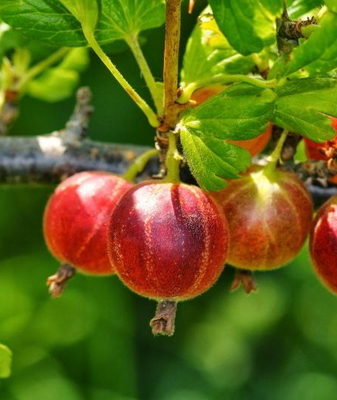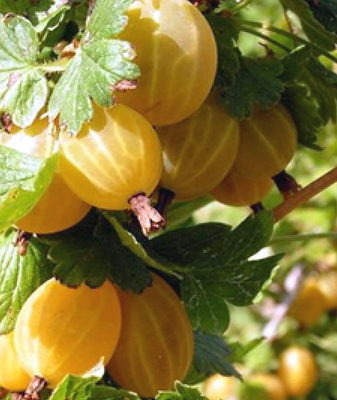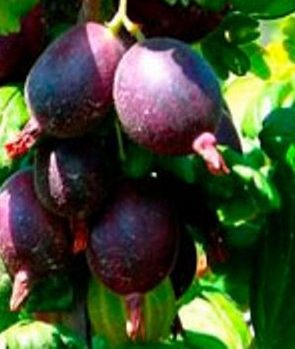Gooseberry Russian yellow
Content:
Currently, a lot of varieties of a wide variety of fruit crops have been bred. The gooseberry, which we all love, is no exception. Gooseberry Russian yellow - we will tell you about this variety today.
It is distinguished by its unusual berry color, as well as excellent aroma and taste. In addition, the Russian yellow gooseberry variety is distinguished by its productivity and unpretentiousness in cultivation. And he was taken out at the Michurin All-Russian Research Institute in the distant 1960s.
The Russian yellow gooseberry was included in the State Register only in 1974, but this gooseberry is still in demand among gardeners. Initially, it was recommended to grow in the Urals and in the North-West region. However, many subjects of the Russian Federation are happy to grow this gooseberry even now.
Gooseberry Russian yellow: variety description and characteristics

Gooseberry Russian yellow: photo of the variety
- Bushes Gooseberry varieties Russian yellow are medium-sized, slightly spreading. Therefore, formative pruning is rarely carried out. Gooseberry shoots grow up to 2 meters in height. So this shrub is classified as tall. The branches are usually straight, not bent to the ground.
- On the shoots quite a lot of thorns. Therefore, it is best to wear gloves or mittens when working with shrubs. By the way, most of the thorns are located at the bottom of the shoot. And while harvesting, you will not damage the delicate skin of your hands.
- Leaves the Russian gooseberry has yellow bright green, and the ends are slightly curved. The berries of the Russian gooseberry are quite large, the average weight of one such berry is 6 grams. They are round, oval, yellow flesh, firm and juicy. There is a pleasant waxy coating on the skin, and the aroma is incredibly refreshing.
- Dense berries hang on branches for a very long time, do not crack. Therefore, you can harvest when all the fruits are ripe, and you have free time. To taste, gooseberries are sweet and sour, very tender.
Gooseberry variety Russian yellow: features
- Up to 4 kg of ripe fragrant berries are usually harvested from one bush, so the yield of this variety is quite high. The fruits generally ripen together, hang on the branches for a long time.
- The gooseberry variety Russian yellow is very drought-resistant and winter-hardy, however, in severe winters, it is still recommended to cover the bushes.
- If we talk about the ripening time, then it should be noted that this variety is mid-season. Therefore, you will pick the first berries in the middle of summer.
- The fruits can be transported over long distances, since they do not lose their presentation for a very long time. Berries do not crack for a very long time due to the dense pulp and skin.
- The disease resistance of the Russian yellow gooseberry is also high.
- Speaking about the advantages of growing, some disadvantages of the variety should be noted. Among them, gardeners note that the gooseberry has many sharp thorns, which make it a little difficult to work in the garden with plants, and the crop must be harvested just as carefully.
It is important to note, all thorns are located mainly on the lower shoots, therefore, picking berries, you will not injure your hands. The fruits are mainly formed at the top.
Gardeners also say that Russian yellow gooseberries have a sour taste. Therefore, you do not have to rely on good sweetness. Among the advantages, one should highlight the good taste of the fruit, a pleasant presentation, as well as early maturity. Russian yellow is resistant to disease, drought and frost.And its fruits are truly universal.
How to grow Russian yellow gooseberries?

Gooseberry Russian yellow: photo of the variety
Before you get the long-awaited harvest, you need to grow the Russian yellow gooseberry.
- In order for plants to develop well, they need to create favorable conditions.
- The gooseberry variety Russian yellow needs good natural light, no drafts, fertile and loose soil. Depending on how actively the area is illuminated, the gooseberry fruit will be more or less tasty.
- The fact is that it is in the sun that berries gain sugar. Therefore, if you plant gooseberries in the shade, then the fruits will be more acidic. It is recommended to plant this variety on slopes. Moisture accumulates in the lowlands, and in excess it negatively affects the growth of gooseberries. And plants do not need cold air.
- If we talk about the type of soil, then it should be noted that gooseberries grow well on fertile soil. You can plant this culture on loam or sandy soil. In heavy soil, it is best to add compost and sand. This is done in order to loosen the soil.
- Gooseberry Russian yellow is recommended to be planted either in late autumn or in spring. It is best to do this in warm weather. For planting, choose one-year and two-year seedlings. It is important to note that the root system of plants must be well developed, and the branches must have active buds.
- Therefore, before buying seedlings in the nursery or on the market, carefully study the structure of the plants. If there are traces of rotting on the seedling, as well as cracks or defects, then it is better not to buy such a gooseberry.
- Before planting the Russian yellow gooseberry variety, it is advisable to loosen the soil, and also remove all debris and weeds from the site. Planting holes are usually dug in the form of a rectangle or circle. The hole must be at least half a meter deep.
Moreover, it is important to note, digging a hole should be a month before planting plants. In order for the land to settle during this period. Some gardeners recommend doing the following: if you plant gooseberries in the spring, then dig a hole before winter, and if planting work is planned in the fall, then you should prepare the holes in the spring of the same year.
- Often crushed stone or sand is placed in the planting holes in order to create a drainage layer around the roots. Humus, superphosphate and potassium sulfate, as well as other types of fertilizers, are also added to the soil. The seedling is placed in a hole, the roots are well straightened and covered with earth.
- After the trunk circle is actively compacted, and the bushes are watered. After that, it is advisable to cut off the shoots on the seedling, leaving 5 active buds on each branch. Also, gardeners recommend mulching the topsoil so that moisture evaporates less.
- If you plan to plant multiple gooseberry bushes, keep your distance. There should be at least one and a half meters between plants, and up to 3 meters between rows.
About the care of the variety

Gooseberry Russian yellow: photo of the variety
- Gooseberry Russian yellow needs regular pruning and feeding.
- If your region has a harsh winter, then you should also do the preparation for wintering.
- As we noted earlier, the shoots of the Russian yellow gooseberry variety are strong enough, so they need additional support. When the berries ripen, the branches bend very strongly in the ground, the fruits begin to rot, the shoots break. Therefore, it is advisable to pull a net around the bush with support on wooden pegs. This will strengthen the gooseberries, and will also keep the fruit clean and tidy.
- It is believed that if you add fertilizer to the planting hole, you do not need to feed the gooseberries in the next few years. However, mature plants still need fertilization. It is best to feed gooseberries in early spring, during flowering and about a month after.
- Gardeners love to feed Russian yellow gooseberry bushes with mullein solution, as well as other natural mixtures. The bushes are usually watered after it snows. So the plants will develop intensively, and the soil will be saturated with nitrogen, which is so necessary for plants to build up green mass.
- During flowering, it is best to feed the plants with complex fertilizer. For this, potassium sulfate, superphosphate is very often used. Usually they are diluted in water and watered with the resulting solution of the bushes at the root. After the gooseberry has faded, it should also be fed with phosphorus-potassium fertilizer.
Note, the plants are also fed by the foliar method, spraying the leaves of the bush with appropriate solutions.
- Gooseberries are usually cut off before sap flow begins. Formative pruning helps to rejuvenate shoots and prevent the development of many diseases. When pruning, it is best to remove dry, diseased and deformed shoots. The branches that thicken the bush will also need to be removed.
- You also need to take care of old branches. Remember, the shoots are capable of bearing fruit for 8 years, then they must be cut off. It is easiest to identify such old shoots by the color of the bark. It should be dark brown.
Gooseberry Russian yellow propagates by cuttings, layering and dividing the bush.
The most productive way is grafting... In order to prepare the necessary shoots, you need to measure 20 cm of strong branches, and separate the cuttings from the mother bush with an oblique cut. Then they will need to be processed in a growth stimulator, planted in moistened sand or loose soil, and put in a basement or cellar for the winter.
In early spring, roots should already appear on them. This means that the plant can be transplanted to a permanent location.
To propagate gooseberries layering, you will need to dig the strongest shoots into the grooves. And in the fall, already separate them from the bush and plant them in a permanent place.
If you transplant gooseberries, then you can divide bush and get some healthy seedlings. It is important to leave a well-developed root system on each of them. Before wintering, it is better to carry out some preventive work.
Water the bushes abundantly in late autumn, so they will be protected from freezing. Young shoots should be spud and covered with spruce branches. And when it snows, then throw a snowdrift on the bush. Thus, the gooseberry will better endure the cold.
About the fight against diseases and pests

Gooseberry Russian yellow: photo of the variety
Gooseberry Russian yellow is often sick powdery mildew... A white bloom appears on the leaves, then it darkens and captures more and more leaves, twigs and fruits.
In order to prevent the development of this disease, it is recommended to water the bushes with hot water in early spring. this is done to kill the fungus. Many gardeners also recommend preventive spraying with copper-based preparations.
If white spots appear on the leaves of the gooseberry, which eventually turn brown, and the leaves begin to dry out and fall off, then this anthracnose... In order to overcome this disease, you need to treat the bushes with Bordeaux liquid. The soil is recommended to be impregnated with potassium permanganate, as well as other chemical agents.
To get rid of rust, it is necessary to carry out preventive measures in a timely manner. Disinfect garden tools and trim bushes in a timely manner.
If speak about pests gooseberry, it should be noted that aphids, spider mites, caterpillars and fireflies often settle on the bushes. In order to get rid of these pests, you will need to spray the gooseberries with wormwood infusion, treat them with insecticides, manually collect the caterpillars and sprinkle the leaves and stems with wood ash.
In the spring, it is also recommended to water the bushes with boiling water.Dig up the ground near the gooseberries more often, as pests hibernate there.
Gooseberry Russian yellow: reviews of gardeners
- Rimma Alexandrovna, Samara region: “I think the Russian yellow gooseberry is an excellent variety that is suitable for growing both on an industrial scale and in home gardens. Gooseberry berries are sweet, aromatic. But this variety is unpretentious in care, which I really like, since other varieties of gooseberries in my area need constant supervision. "
- Alexander Viktorovich, Chelyabinsk region: “I can't say anything bad about the Russian yellow gooseberry variety. The variety is winter-hardy and drought-resistant, the yield is excellent, the taste characteristics are pleasantly surprising, and he did not notice any particular difficulties in growing the variety. Try to plant a Russian yellow gooseberry in your area, and it will certainly delight you. "




